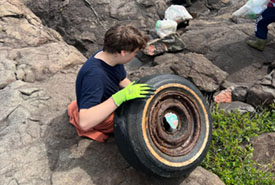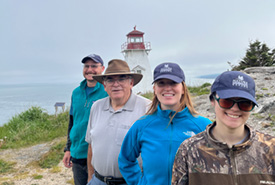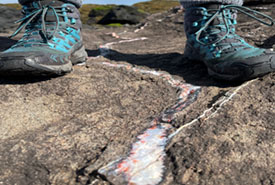Nova Scotia Youth at Boar’s Head Nature Reserve

Student collecting marine debris at Boar's Head, NS (Photo by NCC)
Way out on the westernmost tip of Nova Scotia lies an island known as Long Island. At about 15 kilometres long and only five kilometres wide, this narrow strip of land is surrounded on every side by the famous high tides of the Bay of Fundy. The Boar’s Head Nature Reserve lies on the west coast of the island, near the community of Tiverton.
On June 9, 2023, 13 people set out to Boar’s Head for a marine debris shoreline cleanup. Included among these people were seven eager Grade 10 students from Islands Consolidated School and their teacher, Rayanne Amirault. Part of a community-based learning program, the students and their teacher had already participated in several hands-on activities around their communities, such as the cleanup.
Also at the event were four representatives from the Nature Conservancy of Canada (NCC). It was foggy when conservation biologist Sam Ceci and interns Jill Ramsay, Matt Nettle and Erin Cooper arrived at the Boar’s Head Nature Reserve. Miraculously, the sun peeked through the thick clouds as soon as the students began to arrive. The fog rolled away, leaving the group with a breathtaking view of the Bay of Fundy.
“It was like the weather was cheering us on,” Jill recalls fondly. And that was just the beginning of the experience.

Matt Nettle, Roger Outhouse, Jill Ramsay, et Erin Cooper (Photo de CNC)
This was the second year of cleanup at Boar’s Head, organized by a former teacher from Islands Consolidated School, Roger Outhouse. Roger has lived on Long Island his entire life, and over the years he has gained practical knowledge of the land he calls home and the bay that surrounds it. He is enthusiastic about sharing his knowledge with others, especially the youth who will grow up to care for the Island that he loves so dearly.
Before becoming a teacher, Roger spent time as a fisherman. He explained to the group that this cleanup was important not only because they were helping to protect nature, but also because they were helping local communities thrive. Fishing is one of the main industries in the area, and many locals rely on a clean and healthy marine environment for stable careers.
Once, when Roger was a fisherman, an abundance of surplus potatoes ended up in the water near Long Island. Roger found himself scooping the potatoes out of the water for a long time after that incident. As he told the group, most people may not think of potatoes as marine debris, but they don’t belong in the ocean any more than plastic does!
The group picked up debris along the rocky shoreline for three hours in the morning. In total, they walked 500 metres and collected 19 extra-large garbage bags of trash. They also found a large tire and a massive buoy that did not fit into their bags and had to be hauled back separately.
Behind the cleanup crew, a dense coniferous forest pressed against the rocky shoreline, and the Boar’s Head Lighthouse stood guard on the edge of the steep cliffs. Matt noticed that the dark grey-green basaltic rock was rather different from the granite shorelines he grew up seeing in Halifax. The rock, with its scattered veins of mineral deposits, was a reminder of the beautiful diversity of the Nova Scotia coastline.

Quartz et agate, Réserve naturelle Boar's Head, N.-É. (Photo de CNC)
Hiking along the rocky coast with big heavy bags of trash was no easy task, but the students were careful to look out for themselves and others. They were very good at communicating when they needed a break and offered to help out when others got tired. They also came up with the idea of tying together several buoys to drag them rather than carrying each individually. They, more than anyone, understood that they needed to work together to get the job done.
After a morning of hard work, the group had lunch at a local pub, which had opened its doors specifically to the cleanup crew. Several of the students discovered some instruments in the corner and were excited to show off their musical talents to their new friends. Their high spirits throughout the whole day showed Erin that they recognized the cleanup was more than a necessary task. “It’s not just doing something for the environment,” says Erin, “it’s also fun.”
All three interns agreed that it was extra special to be able to connect with the students through food and music after the event. Not only did it make the experience feel more personal, but NCC relies on volunteers for a great deal of our nature conservation work. Events like the cleanup would not be possible without the support of passionate and devoted locals, such as the students. These youths are truly the hopeful future of their communities.




